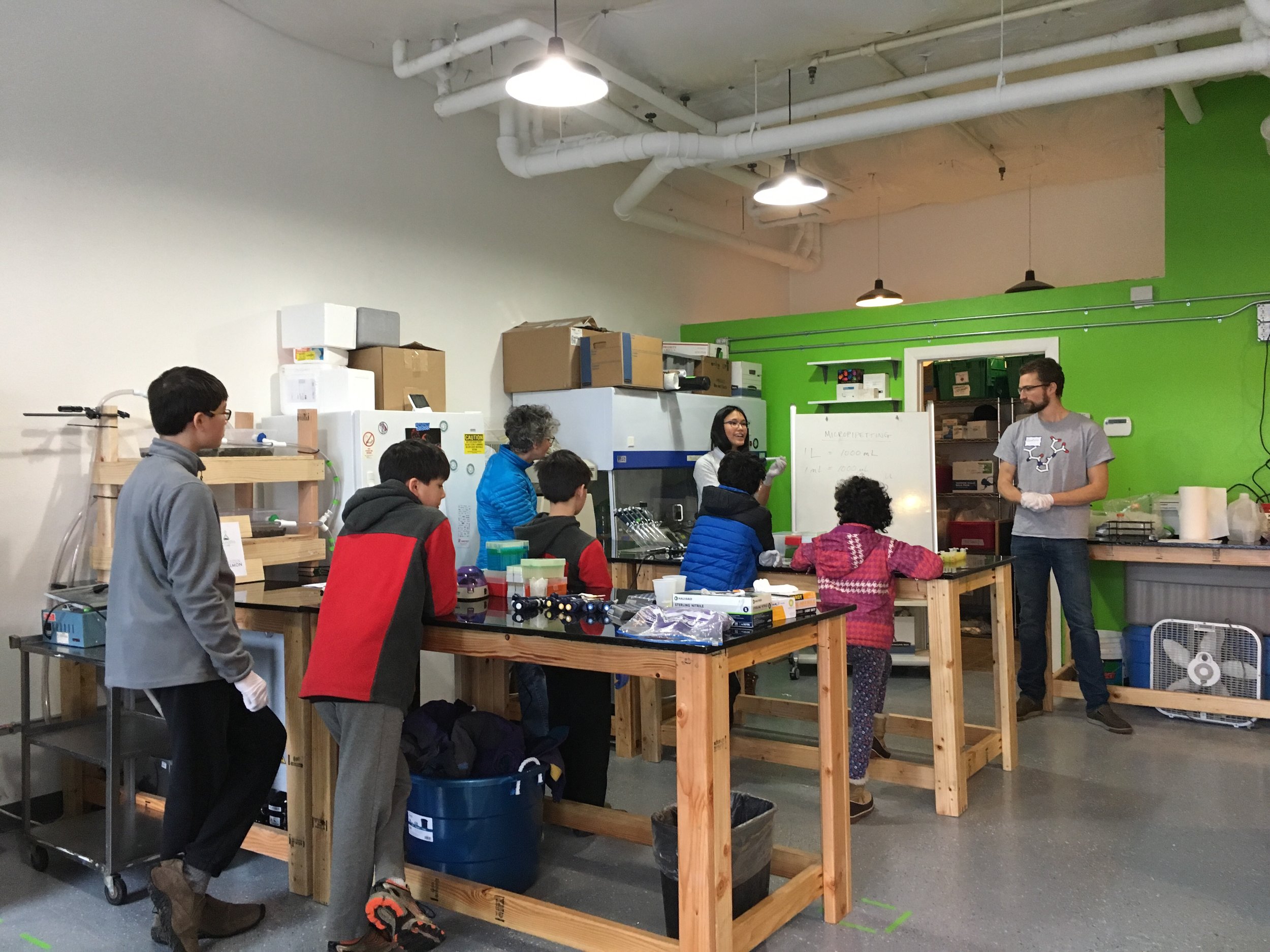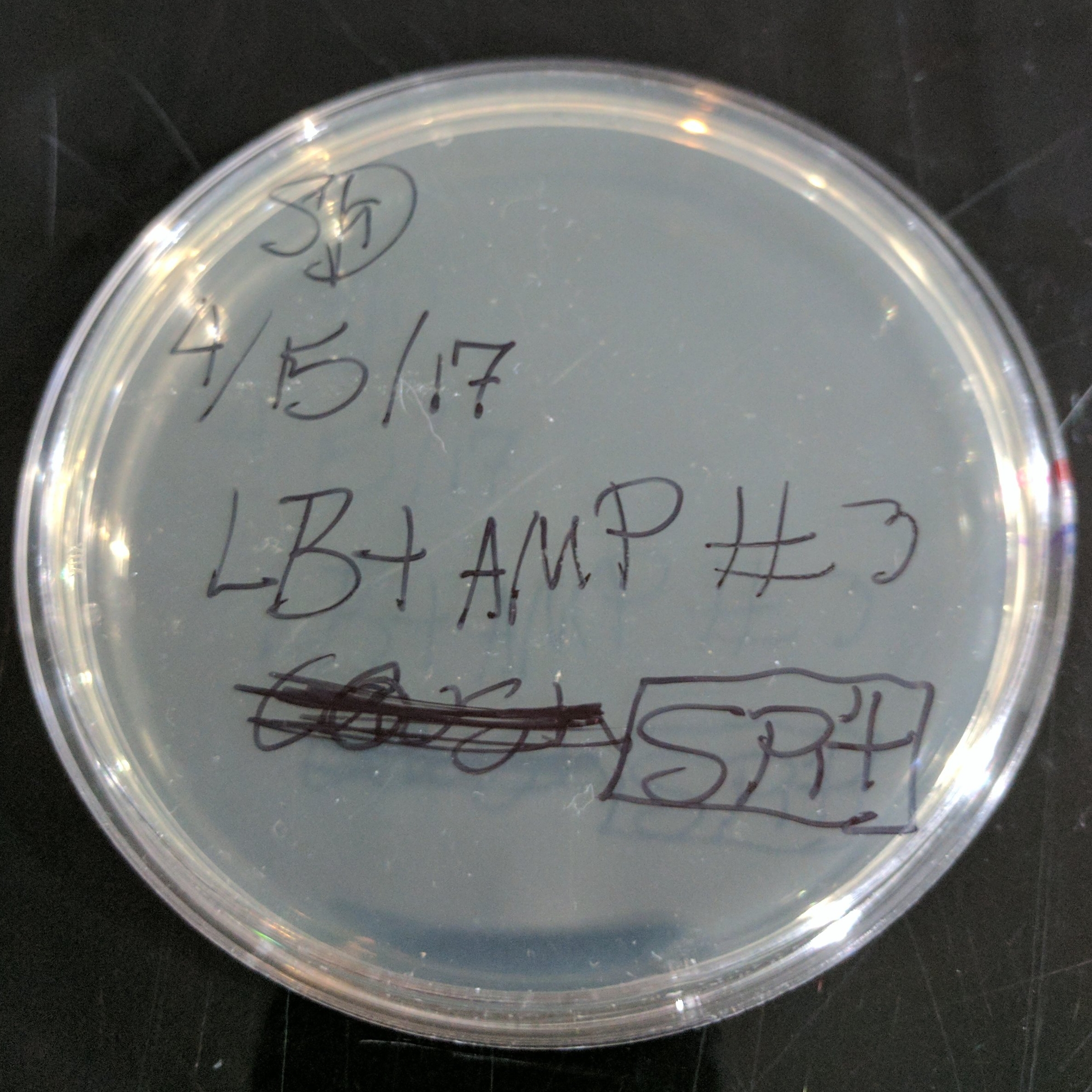Thank you to BioHack The Planet for recently having us for their 2017 Conference in Oakland, CA! We had a productive few days of discussion, collaboration and presentation with like-minded biohackers; you can check out a list of all the fantastic speakers here. Watch SoundBio's talk here, and for last year's talk at BioHTP by one of our projects, Citizen Salmon, click here!
BACTERIAL PAINTINGS FOR EASTER (APR 15, 2017)
Instead of painting eggs, we decided to paint with E.coli. During this event, fellow DIY scientists made living pieces of art using E.coli that had been transformed to express fluorescent proteins. We tried to use five colors with varying levels of success. (Sorry everyone, looks like purple and yellow had some issues. Hopefully next time we can make solid colors.)
Here are the results of everyone's beautiful work. Scroll through and find your favorite. I tried to group the pictures by the artist. Please tell me if I miss a plate!
MOLECULAR SCISSORS (APR 1, 2017)
Molecular Biologist Toolkit: Restriction Enzymes
A staple in any DIY biologists' toolkit is the restriction enzyme. These nifty proteins can be used to cut DNA at specific sequences of bases producing either blunt or "sticky" ends. When the "sticky ends" are complementary the DNA combines and can result in a new sequence. Knowing how to use restriction enzymes is the first step in synthetic biology.
During our third and final workshop in the Lab Skills 101 Series, participants utilized techniques gained from the previous two classes and added one more skill to their molecular toolkit. Participates used three common restriction enzymes (EcoRI, BamHI, HindIII) to cut bacteriophage DNA. To assess if their cuts were successful, we ran gels to see the band patterns. It was really fun to observe positive outcomes with successful digests!
- Jaylin and Regina
BACTERIA PAINTINGS!
THE MIXING OF ART AND SCIENCE CAN PRODUCE AMAZING RESULTS.
A few months ago we tested out one of our first workshops at Amazon's Expressions Lab. Using K-12 safe E.coli transformed with a plasmid (piece of DNA) to express fluorescent colored proteins, we invited people at Amazon to paint a picture on agar plates. The fun part of painting with bacteria is that it produces a piece of art that changes over time as the colonies grow larger and eventually die off. Its truly a living painting. Here are some of the results:
-Regina
CANDY ELECTROPHORESIS (MARCH 25, 2017)
DIY ELECTROPHORESIS (Under $10 a piece!)
Gel electrophoresis, at its most basic components, is a polymer matrix and electricity used to separate molecules by size, shape, and charge. Its a common lab technique and an extremely useful one. For our DIY Electrophoresis system, we used:
- 5 - 9V batteries ($1 a piece at FamilyTree)
- 2 - Leads with alligator clips ($7 for 10)
- Silver wire or 2 paper clips (took from the office)
- Square petri dish or small rectangular container (forever borrowed from kitchen)
- <1g - Food-grade agar-agar powder ($7 for much more than you'll need)
- Tape (took from office)
- 2 - Popsicle sticks: thin and "normal" ($4+$7)
- Baking soda (<$1 a box!)
Amazingly, it worked like a charm (if the charm was a dependable electrophoresis system)! So, we invited science-lovers from our MeetUp to take part in a workshop where they made their own DIY electrophoresis systems and used it to separate the dyes found on Skittles.
Thanks to everyone that was able to join us!
- Regina
MICROPIPETTING WORKSHOP (MARCH 18, 2017)
MICROPIPETTING WORKSHOP
We held our first official workshop in the lab following our launch party on March 11th! We had a great turnout and we are pleased to see strong interest come from many different age groups. Our education guru, Regina, talked about the importance of laboratory basics and pipette-handling techniques, and then everyone got to practice and perfect their own skills via fun and engaging activities. Success! Check out more of our classes on our MeetUp page.




Bioluminescent Map of Seattle
Painting with Bacteria to Celebrate Seattle
For our launch party held on March 11, 2017, we wanted to celebrate our new space in our amazing city. The week prior, we took a trip to Uwajimaya to find some fresh Pacific fish for sourcing our bioluminescent bacteria that we would use to create a glowing map of the city of Seattle. It was displayed on one of our handmade lab benches and when it got dark enough that evening, we shut off the lights and amazed our guests with a living map!
Summary
Naturally glowing bacteria can easily be found in the ocean. By incubating a marine fish (in our case, Pacific Herring), in a sea water broth, glowing bacteria like Vibrio fischeri can be isolated. These bioluminescent bacteria are “social” organisms and will only glow if there are enough of their “brothers and sisters” around. This regulation of gene expression in response to population density as coordinated behavior is called "quorum sensing", and these bacteria produce and release chemicals that induce the mechanism for creating light.
Methods
The fish were sourced from Uwajimaya (as all good fish are!). We chose pacific herring and rockfish because they were "fresh" (never-frozen) marine fish. (We learned at a later date that the rockfish was sourced from a channel rather than open ocean.) We incubated the fish for 48 hours in sterile sea water bought from a pet store. After incubation, we streaked seawater agar plates from the brightest areas of the fish. Conveniently, V. fischeri grow best around room temperature. To isolate the glowing bacteria, we did 3 rounds of incubating and replating bright colonies. This involved waiting in the dark until our eyes acclimated and circling glowing colonies by marking the backs of petri dishes. We spent a lot of time in the restroom (the only dark place in the lab!).
Conclusion
This was an amazing experience and piece of living art that our SoundBio team and community worked together to make happen. Thanks everyone!
- Regina Wu
























































































































